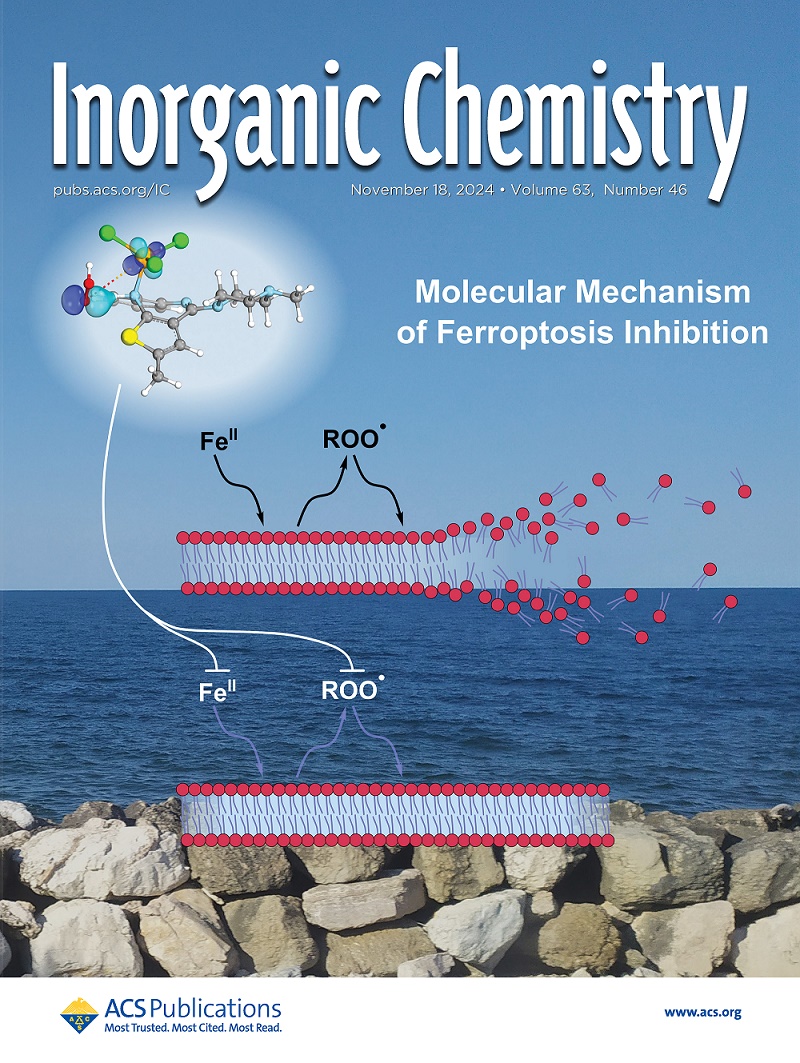两性锌(II)氢化物阳离子 [ZnH]+:双吡啶配体的影响
IF 4.7
2区 化学
Q1 CHEMISTRY, INORGANIC & NUCLEAR
引用次数: 0
摘要
末端氢化锌阳离子[(Me2bpy)ZnH(L)][BArF4] (Me2bpy = 6,6 ' -二甲基-2,2 ' -二吡啶基;ArF = 3,5-(CF3)2C6H3;L = THF, 1a;4-(二甲氨基)吡啶,DMAP, 1b;吡啶,1 c;4-(三氟甲基)吡啶,1d)显示Zn-H距离在预期范围内,如THF加合物1a和吡啶加合物1c的单晶x射线衍射所示。除了不稳定的1a外,ν(ZnH)的伸展频率与L配体的给电子特性相关。锌氢键表现出两性行为。1a与ZnEt2反应生成阳离子乙基配合物[(Me2bpy)ZnEt(thf)][BArF4] (2a),同时经过CO2插入形成阳离子形成配合物[(Me2bpy)Zn(OCHO)(thf)][BArF4] (3a)。在80℃下3a的热裂解得到双核金属化产物4a,该产物也是由1a的光解形成的。当与n -杂环碳化合物ItBu (ItBu = 1,3-二叔丁基咪唑-2-乙基)反应时,1a的Zn-H键作为质子供体,得到咪唑盐[ItBuH][BArF4]、金属锌和Me2bpy。1a中的Zn-H键与ZnCp*2 (Cp* =五甲基环戊二烯基)发生去质子化反应,生成二锌(I)阳离子[(Me2bpy) Zn-ZnCp *(thf)][BArF4] (6a)和Cp*H。1a与Cp2MoH2 (Cp = η - 5-环戊二烯基)反应生成了杂双金属配合物[(Me2bpy)Zn(μ-H)MoCp2]+[BArF4]−(7)。本文章由计算机程序翻译,如有差异,请以英文原文为准。
![Amphoteric Zinc(II) Hydride Cations [ZnH]+: Effect of a Bipyridyl Ligand](https://img.booksci.cn/booksciimg/2025-4/2025042510639442552986.png)
Amphoteric Zinc(II) Hydride Cations [ZnH]+: Effect of a Bipyridyl Ligand
Terminal zinc hydride cations [(Me2bpy)ZnH(L)][BArF4] (Me2bpy = 6,6′-dimethyl-2,2′-dipyridyl; ArF = 3,5-(CF3)2C6H3; L = THF, 1a; 4-(dimethylamino)pyridine, DMAP, 1b; pyridine, 1c; 4-(trifluoromethyl)pyridine, 1d) show Zn–H distances in the expected range, as exemplified by single-crystal X-ray diffraction for the THF adduct 1a and the pyridine adduct 1c. With the exception of labile 1a, the ν(ZnH) stretching frequencies correlate with the electron donating character of the L ligand. The Zn–H bond shows amphoteric behavior. Reaction of 1a with ZnEt2 gives the cationic ethyl complex [(Me2bpy)ZnEt(thf)][BArF4] (2a), while it undergoes CO2 insertion to form the cationic formato complex [(Me2bpy)Zn(OCHO)(thf)][BArF4] (3a). Thermolysis of 3a at 80 °C gives the dinuclear metalation product 4a, which is also formed by photolysis of 1a. The Zn–H bond of 1a acts as a proton donor when treated with the N-heterocyclic carbene ItBu (ItBu = 1,3-di-tert-butylimidazol-2-ylidene), giving the imidazolium salt [ItBuH][BArF4], zinc metal, and Me2bpy. The deprotonation of the Zn–H bond in 1a occurs with ZnCp*2 (Cp* = pentamethylcyclopentadienyl) to give the dizinc(I) cation [(Me2bpy)Zn–ZnCp*(thf)][BArF4] (6a) and Cp*H. Reaction of 1a with Cp2MoH2 (Cp = η5-cyclopentadienyl) leads to the heterobimetallic complex [(Me2bpy)Zn(μ-H)MoCp2]+[BArF4]− (7) under H2 elimination.
求助全文
通过发布文献求助,成功后即可免费获取论文全文。
去求助
来源期刊

Inorganic Chemistry
化学-无机化学与核化学
CiteScore
7.60
自引率
13.00%
发文量
1960
审稿时长
1.9 months
期刊介绍:
Inorganic Chemistry publishes fundamental studies in all phases of inorganic chemistry. Coverage includes experimental and theoretical reports on quantitative studies of structure and thermodynamics, kinetics, mechanisms of inorganic reactions, bioinorganic chemistry, and relevant aspects of organometallic chemistry, solid-state phenomena, and chemical bonding theory. Emphasis is placed on the synthesis, structure, thermodynamics, reactivity, spectroscopy, and bonding properties of significant new and known compounds.
 求助内容:
求助内容: 应助结果提醒方式:
应助结果提醒方式:


